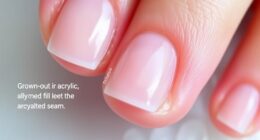During chemotherapy, take gentle care of your nails by using soft, chemical-free polishes and avoiding harsh removers. Keep your nails clean, dry, and moisturized, trimming and filing them smooth to prevent snagging. Wear gloves during chores and avoid biting or picking your nails. Use nourishing treatments designed for sensitive nails, and watch for signs of infection or damage. Staying proactive helps keep your nails healthy—discover more tips to protect your nails throughout your treatment.
Key Takeaways
- Use gentle, chemical-free nail polishes and avoid harsh removers to protect nail health during treatment.
- Keep nails trimmed, filed smoothly, and moisturized to prevent breakage and promote strong growth.
- Wear gloves during chores involving water or chemicals to prevent trauma and infections.
- Incorporate nourishing nail products and avoid aggressive treatments or acrylics that can weaken nails.
- Seek medical advice for persistent nail changes or signs of infection to ensure proper care and prevention.
Understanding How Chemotherapy Affects Your Nails

Chemotherapy can profoundly impact your nails by disrupting their normal growth and strength. You might notice changes in nail pigmentation, such as darkening or lightening, which occur due to the treatment’s effect on nail cells. Additionally, nail ridging often develops, creating vertical lines that run from cuticle to tip. These ridges happen because chemotherapy affects the keratin-producing cells in your nails, impairing their smooth growth. Changes in pigmentation and ridging are common signs that your nails are responding to treatment, but they typically aren’t permanent. Understanding these effects helps you recognize normal reactions versus signs of infection or other issues. While these nail changes can be unsettling, they are usually temporary and part of the broader impact chemotherapy has on your body’s cellular processes. Nail health can be further supported by proper nail care practices during treatment.
Essential Nail Care Practices During Treatment

To protect your nails during treatment, adopting gentle and consistent care practices is essential. First, prioritize nail polish safety by avoiding harsh chemicals like formaldehyde or toluene. Opt for formulas labeled as “3-free” or “14-free,” which are gentler on your nails. When applying nail polish, use thin coats and ensure proper removal to prevent damage. Incorporate nail strengthening methods, such as using a nail hardener or a nourishing base coat, to bolster weak nails. Keep nails trimmed and filed smoothly to prevent snagging. Avoid aggressive buffing or peeling polish, which can thin nails further. Regularly moisturizing your cuticles and nails with a gentle oil or cream maintains hydration and resilience throughout your treatment. Additionally, practicing proper nail care techniques can help minimize damage and promote healthier nail growth during chemotherapy.
Tips for Preventing Nail Damage and Infections

Since your nails can become more fragile and prone to infection during treatment, taking proactive steps to prevent damage is essential. Focus on nail strengthening techniques and infection prevention strategies to keep your nails healthy. Keep nails trimmed and avoid biting or picking at them. Regularly moisturize your cuticles and nails to maintain strength and flexibility. Use protective gloves when doing chores or exposing your nails to water and harsh chemicals. Here’s a quick reference:
| Nail Care Tip | Why It Matters |
|---|---|
| Keep nails dry and clean | Prevents infections |
| Use gentle nail tools | Avoids nail trauma and damage |
| Apply nourishing oils | Supports nail strengthening and flexibility |
Implementing these tips helps reduce damage risks and keeps your nails healthier during chemotherapy. Proper nail care practices are vital for maintaining overall nail health and preventing complications.
Choosing Safe Nail Products and Treatments

Choosing safe nail products and treatments is essential to protect your nails during chemotherapy. You want to minimize exposure to harsh chemicals and irritants that could worsen nail damage. Opt for nail polish safety by selecting formulas that are free from formaldehyde, toluene, and DBP. Fragrance-free products are also preferable, as they reduce the risk of allergic reactions and irritation. When selecting treatments, look for non-toxic, breathable options that allow your nails to stay healthy. Additionally, considering products with electric dirt bike technology can help ensure better safety and durability of your nails during this sensitive time.
When to Seek Medical Advice for Nail Concerns

If you notice persistent or worsening nail issues despite using safe products, it’s important to consult your healthcare team promptly. Nail discoloration, such as darkening or unusual stains, can signal infection or other complications that need medical attention. Similarly, increasing nail brittleness or nails that crack easily might indicate underlying problems related to chemotherapy side effects. Don’t ignore these signs, especially if they’re accompanied by pain, swelling, or pus. Prompt medical advice helps rule out infections or other conditions requiring treatment. Early intervention can prevent further damage and discomfort. Always communicate any changes in your nails clearly to your healthcare providers so they can assess the severity and recommend appropriate care or treatments. Your proactive approach is key to maintaining nail health during chemotherapy. Additionally, understanding herbal teas and their potential benefits may support overall wellness during treatment but should not replace medical advice for nail concerns.
Frequently Asked Questions
Can Nail Changes From Chemotherapy Be Permanent?
Nail changes from chemotherapy can sometimes be permanent, especially if you experience long-term effects like nail loss or permanent ridges. While most nail issues improve after treatment ends, a few people may notice lasting changes. To minimize risks, follow proper nail care routines and consult your healthcare provider if you see persistent or severe nail problems. Staying proactive helps support healthy nail recovery and reduces the chance of permanent damage.
Are There Specific Vitamins or Supplements to Support Nail Health?
Yes, taking vitamin supplements like biotin can dramatically boost your nail health, making them stronger, longer, and less prone to damage. Biotin benefits are well-known for supporting nail growth and preventing brittleness. Consider incorporating a high-quality biotin supplement into your routine and guarantee you get enough essential vitamins like A, C, and E. This powerful combo can transform your nails from fragile to fierce, even during chemotherapy.
How Can I Differentiate Between Normal Nail Changes and Infections?
You can tell the difference between normal nail changes and infections by watching for signs to watch for. Infection versus change often shows symptoms like redness, swelling, pain, pus, or a foul odor. Normal changes, such as discoloration or ridges, usually don’t cause discomfort or swelling. If you notice persistent or worsening symptoms, it’s best to consult your healthcare provider promptly to prevent complications.
Do Any Natural Remedies Help Strengthen Nails During Treatment?
Coincidentally, some home remedies can support nail strengthening during treatment. Applying coconut oil or olive oil regularly helps moisturize and fortify your nails naturally. Biotin supplements may also promote stronger nails, but check with your doctor first. Avoid harsh chemicals and opt for gentle, nourishing products. These natural remedies, combined with proper nail care, can help keep your nails healthier through your chemotherapy journey.
Can Nail Polish or Artificial Nails Be Safely Used During Chemotherapy?
You can use nail polish during chemotherapy, but you should prioritize nail polish safety by choosing non-toxic, formaldehyde-free options. Be cautious with artificial nails, as they pose risks like infection or damage to your nails and skin, especially when your immune system is compromised. It’s best to consult your healthcare provider before applying any nail products, and consider avoiding artificial nails altogether during treatment for ideal nail health.
Conclusion
Taking care of your nails during chemotherapy isn’t just about appearance — it’s about safeguarding your overall health. Some believe that maintaining healthy nails can boost your confidence and resilience, but it’s more than that; it’s a reminder that even small steps matter in your healing journey. By staying vigilant and caring for your nails, you support your body’s strength and recovery. Remember, what seems minor can actually have a meaningful impact on your well-being.









